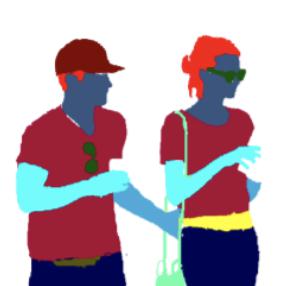Human Parsing
56 papers with code • 1 benchmarks • 2 datasets
Human parsing is the task of segmenting a human image into different fine-grained semantic parts such as head, torso, arms and legs.
( Image credit: Multi-Human-Parsing (MHP) )
Most implemented papers
CCNet: Criss-Cross Attention for Semantic Segmentation
Compared with the non-local block, the proposed recurrent criss-cross attention module requires 11x less GPU memory usage.
Beyond Appearance: a Semantic Controllable Self-Supervised Learning Framework for Human-Centric Visual Tasks
Unlike the existing self-supervised learning methods, prior knowledge from human images is utilized in SOLIDER to build pseudo semantic labels and import more semantic information into the learned representation.
Look into Person: Joint Body Parsing & Pose Estimation Network and A New Benchmark
To further explore and take advantage of the semantic correlation of these two tasks, we propose a novel joint human parsing and pose estimation network to explore efficient context modeling, which can simultaneously predict parsing and pose with extremely high quality.
Long-Term Person Re-identification with Dramatic Appearance Change: Algorithm and Benchmark
In addition, we propose a network named M2Net, which integrates multi-modality features from the RGB images, contour images and human parsing images.
Multiple-Human Parsing in the Wild
To address the multi-human parsing problem, we introduce a new multi-human parsing (MHP) dataset and a novel multi-human parsing model named MH-Parser.
Understanding Humans in Crowded Scenes: Deep Nested Adversarial Learning and A New Benchmark for Multi-Human Parsing
Despite the noticeable progress in perceptual tasks like detection, instance segmentation and human parsing, computers still perform unsatisfactorily on visually understanding humans in crowded scenes, such as group behavior analysis, person re-identification and autonomous driving, etc.
Devil in the Details: Towards Accurate Single and Multiple Human Parsing
Human parsing has received considerable interest due to its wide application potentials.
Parsing R-CNN for Instance-Level Human Analysis
Models need to distinguish different human instances in the image panel and learn rich features to represent the details of each instance.
Self-Correction for Human Parsing
To tackle the problem of learning with label noises, this work introduces a purification strategy, called Self-Correction for Human Parsing (SCHP), to progressively promote the reliability of the supervised labels as well as the learned models.
Learning from Synthetic Animals
Despite great success in human parsing, progress for parsing other deformable articulated objects, like animals, is still limited by the lack of labeled data.


 PASCAL Context
PASCAL Context
 MHP
MHP

